The Relationship of Kōburyū to Uechi Ryū
Sōke Kaichō Kinjō began his karate career in 1955, studying Shōrin Ryū under the renowned Shōrin Ryū master, Nagamine Shoshin, founder of Matsubayashi Shōrin Ryū. However, in 1959, Sokei Kaichō Kinjō turned to Uechi Ryū under Itokazu Seiki, another karate great and master of Uechi Ryū karate. Sōke Kaichō Kinjō’s lifelong study has been in the Uechi Ryū family of karate styles.
The Uechi Ryū Family
Uechi Ryū is one of the three major branches of Okinawan karate: Shōrin Ryū, Gōjū Ryū and Uechi Ryū. Like the other major branches of Okinawan karate, Uechi Ryū over time splintered into other closely related styles. Until recently, the Uechi Ryū family of karate styles included Uechi Ryū, Pangainoon Ryū, Kōnan Ryū, Shōhei Ryū and Kōburyū.
You can trace the birth of Kōburyū through the maze of Uechi Ryū styles. As contentious as it seems, the creation of new styles was less about the merits of Uechi Ryū and more about politics and interpersonal differences. Until Sōke Kaichō Kinjō, that is. While he dedicated his life to the study of Uechi Ryū, he felt the style could be improved. Failing to effect change within the Uechi Ryū organization, he created Kōburyū.
In preparation for the Tokyu 2020 Olympics, the Uechi Ryū family put aside their differences and now present themselves as one style. Sōke Kaichō Kinjō decided that Kōburyū was different and should remain separate in the hopes that his innovations would not become lost.
Uechi Ryū Family Lineage
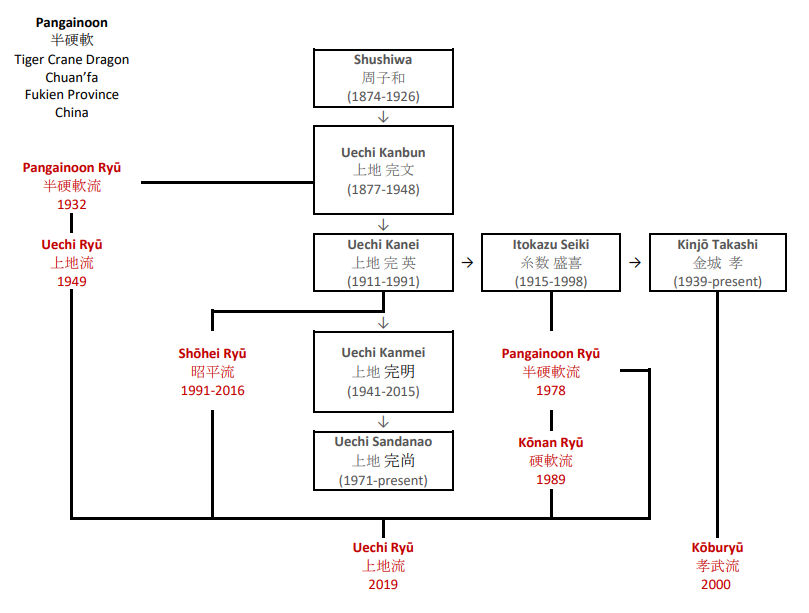
Uechi Ryū
In 1959, Sōke Kaichō Kinjō began to study Uechi Ryū under Itokazu Seiki. Itokazu Seiki encouraged the young Kinjō Takashi, as a godan (5th degree black belt), to teach Uechi Ryū karate. Sensei Kinjō opened his first dojo in 1965, called the Hantagawa Shureikan.
Pangainoon Ryū
In 1978, a group of eight dojo led by Itokazu Seiki separated from Uechi Ryū, mostly due to political differences. This group, including Sōke Kaichō Kinjō’s dojo, returned to the original style name, Pangainoon Ryū, as it was known under Uechi Kanbun. The rift was relatively quickly healed, but Pangainoon Ryū remained separate from Uechi Ryū until very recently. Sōke Kaichō Kinjō continued to teach Pangainoon Ryū with Itokazu Seiki as his teacher and mentor, eventually earning hanshi kyūdan in Pangainoon Ryū before Itokazu’s health declined.
Kōnan Ryū
The origin of the name Pangainoon is obscure, but probably came from a little-known Chinese dialect. It means “half hard soft.” In 1989, Itokazu Seiki decided to change the name, Pangainoon. He removed the first character (半), meaning “half.” This had always caused confusion. Was this style only half hard but fully soft? After dropping the first character he used the Japanese pronunciation for the remaining two kanji (硬軟), leaving Kōnan. The style was then known as Kōnan Ryū. This was simply a name change and was not politically motivated and did not involve style changes.
Shōhei Ryū
Shōhei Ryū is not in the Kōburyū lineage, but it is in the Uechi Ryū family of karate styles. After Uechi Kanei’s death most of the senior practitioners of Uechi Ryū split for political and personal reasons from his son, Uechi Kanmei. The rift was healed in 2016 in anticipation of karate appearing in the 2020 Olympic Games. All Uechi Ryū offshoots, including Shōhei Ryū, were eventually reunited under the name of Uechi Ryū, with the exception of Kōburyū.
Kōburyū
In 2000, Sōke Kaichō Kinjō introduced Kōburyū, a new style based on over 50 years of training and teaching of both Uechi Ryū karate and Matayoshi kobudō, but distinctly different from both. Not just political wrangling or differences in teaching methods, Kōburyū is a whole new movement methodology while retaining the basic structure of Uechi Ryū karate and Matayoshi kobudō kata.
The Uechi Ryū organization had long contended that karate styles and kobudō styles should be separate. However, Sōke Kaichō Kinjō had come to believe that karate and kobudō are like two halves of the same coin – inseparable. He believed that karate and kobudō not only could but should be taught as one style. Thus, Kōburyū incorporates both karate and kobudō.
Sōke Kaichō Kinjō points out that Kōburyū is an evolving style. He is continually developing new ideas.
Who’s Who In the Kōburyū Lineage
Shushiwa

Chou-tzu-ho
周子和
(1874 – 1926)
Shushiwa was not a monk in the Shaolin Temple, though he did use the temple for teaching.
Shushiwa was said to have so rigorously trained his hand for nuki-te that it became deformed like an eagle’s beak.
Uechi Kanbun
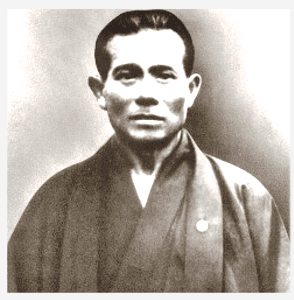
上地 完文
(1877 – 1948)
The founder of the Uechi Ryū family of karate styles is Kanbun Uechi (1877-1948). In 1897, at the age of 20, Kanbun Uechi left Okinawa to avoid being drafted into the Japanese army. Like many martial artists before him, he traveled to China to study the martial arts. At Fuzhou in Fujian Province, China, he became a pupil of Shushiwa, the leading figure of Chinese Nanpa Shorin-ken
Uechi Kanbun and Shushiwa made a living selling herbal remedies. It is said that Uechi Kanbun was a strong man. As part of a street performance, he would take on all comers. The challengers invariably ended up with injuries, which Shushiwa would offer to fix with various herbal remedies and medicines.
, and performed ascetic practices for 13 years. After being full mastership had been conferred, Kanbun Uechi returned home, and then moved to Wakayama City, Wakayama Prefecture, Japan, to find work. In 1925 he established the Institute of Pangainoon Ryū (half-hard soft style) Tōdi-jutsu, the predecessor of Uechi-ryu karate-do, and began the process of launching his own dojo. In 1940, it was renamed Uechi Ryū after him.
During the last three years he also taught Pangainoon . It is said that one of his students killed a man in a dispute over land. Disgraced as a teacher, Uechi Kanbun closed the dōjō in China and returned to Okinawa. In Okinawa it was rumored that Uechi Kanbun was a great karate master and many were interested in learning from him, but for the next 18 years Uechi Kanbun refused to teach.
In 1926, Uechi Kanbun, along with many Okinawans, went to Wakayama, Japan, to work in the clothing industry (bōseki – spinning). There they were harassed by members of the yakuza. Uechi Kanbun’s first student was Tomoyose Ryuyu. In 1927, Uechi Kanei, Uechi Kanbun’s eldest son, moved to Wakayama to study with his father. Uechi Kanei tFutenma City Dojo, Okinawa, and???-dojo in Okinawa?Eventually Uechi Kanbun began to teach some of the Okinawans of Wakayama the skills he had learned in China so that they could defend themselves.
Kanbun Uechi was a holder of kenpo techniques so sharp they were fearful. It has been said that his teaching was based on the principle of hardiness and for handpicked students only. Pupils were allowed to attend only if they had a guarantor. It has been reported that only fellow pupils were allowed to watch the training in those days. Also it was strictly prohibited to do enbu demonstrations in front of other people.
Kanbun Uechi did not leave any notes, so we do not know anything about the history of PanGaiNoon before Shushiwa. Martial artists have traveled to the Fukien Province of China numerous times to attempt to trace the origins of Pangainoon. There is no trace – not even similar kata.
Uechi Kanei
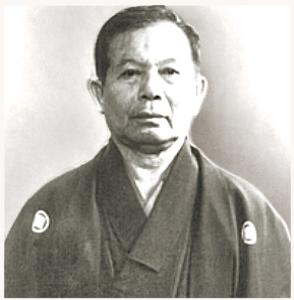
上地 完 英
(1911- 1991)
Thus, the home of Uechi Ryū (called Pangai Nun Ryū until 1940 when Uechi Kanei renamed the style in honor of his father) is Wakayama, Japan, and not Okinawa. While Uechi Kanbun only taught Pangai Nun to Okinawans, he never taught Pangai Nun in Okinawa.
In 1940, Uechi Kanbun’s son, Uechi Kanei, changed the name of Pangai Nun Ryū to Uechi Ryū in honor of his father.
In 1942, Uechi Kanei and his family returned to Okinawa where he began to teach
In 1945, after World War II ended, Uechi Kanbun (at the age of 71) returned to Okinawa. He died in 1948.
In 1958, Kanei Uechi held the first Uechi Ryū dan test and awarded the first belt ranks in Uechi Ryū karate.
American soldiers stationed in Okinawa after World War II were fascinated by karate. Uechi Ryū was the first Okinawan style to accept foreign students. In particular, George Mattson sought training in Uechi Ryū. When he returned home from his tour of duty, he decided to teach Uechi Ryū, becoming the founder of Uechi Ryū in the U.S. From the U.S., Uechi Ryū spread to the rest of the world.
Itokazu Seiki
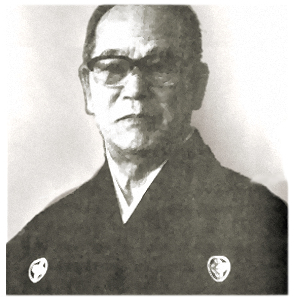
糸数 盛喜
(1915 – 1998?)
Itokazu Seiki was born in Nishihara Town, Okinawa, in 1915. In 1933, Itokazu began studying Shuri-te under Chotoku Kyan. In 1938, he began studying Pan Gai Noon Ryū, under Uechi Kanei. After the end of World War II, he studied under Uechi Kanbun at the Wakayama dōjō near Osaka.
At this time Uechi Ryu included only the three kata brought from China. In the late 1950’s, Uechi Kanei chose a group of senior instructors to create intermediate kata and otherwise systematize the techniques of Uechi Ryū. Itokazu, as part of this effort, created the kata called Dainiseisan.
In 1970, Itokazu became vice-president of Uechi Ryu Karate-do Association. In 1976, he became vice-president of All Okinawa Karate-do Renmei.
However, in 1978 a group of dojo heads led by Itokazu Seiki and his student, Kinjo Takashi, decided to break from Uechi Ryū and return to traditional Pan Gai Noon Ryū.
Itokazu Seiki was elected as the first president of Pan Gai Noon Ryū Karate-do Renmei. In 1990, he renamed the organization Okinawa Konan Ryu Karate-do Association, using the Japanese pronunciation of the kanji for Gai Noon Ryu, meaning hard-soft style.
In 1997, Itokazu was recognized by by Okinawa Prefecture as an Intangible Cultural Asset in the field of Okinawan Karate and Kobudo.
He was awarded Okinawa Konan Ryu Hanshi 10th Dan by his peers.
Kinjō Takashi
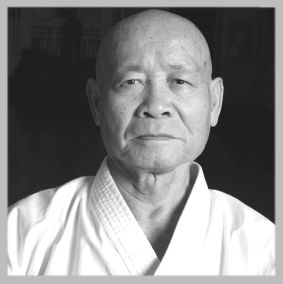
金城 孝
(1939 – present)
Beginning in 1959, Sōke Kaichō Kinjō studied Uechi Ryū under Itokazu Seiki. Itokazu Seiki was a direct student of Kanbun Uechi and later of Kanei Uechi. Itokazu Seiki encouraged the young Kinjō Takashi as a godan (5th degree black belt) to teach Uechi Ryū karate. Sensei Kinjō opened his first dojo in 1965, called it the Hantagawa Shureikan. Hantagawa is a locality within Naha City, Okinawa.
In 1978, a group of eight dojo, led by Itokazu Seiki and including Sensei Kinjō’s dojo, went back to the original style name, Pangainoon Ryū. The rift was relatively quickly healed, but Pangainoon Ryū remained separate from Uechi Ryū until very recently. Sōke Kaichō Kinjō continued to teach Pangainoon Ryū with Itokazu Seiki as his teacher and mentor, eventually earning hanshi kyūdan in Pangainoon Ryū before Itokazu’s health declined.
Pangainoon means “half hard soft.” It was a type of Chinese kung fu studied by Kanbun Uechi in China. The same kanji in Japanese are pronounced Hankōnan. In 1989, Itokazu Seiki renamed Pangainoon Ryū, choosing to use the Japanese pronunciation of the kanji. The kanji for “half” was dropped to better indicate a balance between hard and soft, resulting in Kōnan Ryū. More importantly, Kōnan Ryū, unlike Uechi Ryū or Pangainoon Ryū, included both karate and kobudō under one organization. However, karate and kobudō were not yet into one style.
Uechi Ryū Group
November 18, 1949
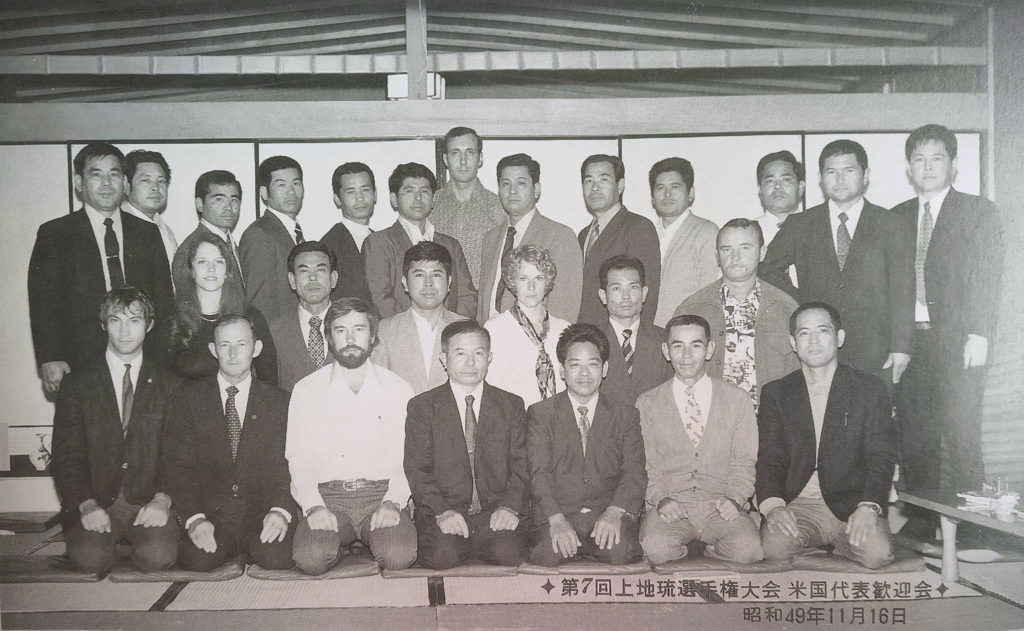
Itokazu Seiki back row 3rd from right
George Mattson front row 3rd from left
